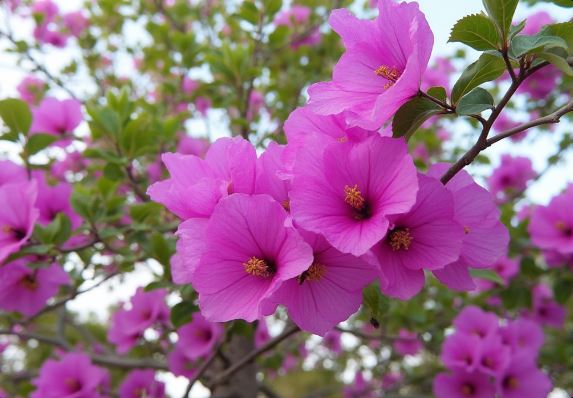
Bougainvillea spectabilis, often referred to as the Great Bougainvillea, is one of the most popular and iconic species of Bougainvillea. It’s characterized by vibrant, showy bracts that come in a range of colors, including magenta, purple, crimson, and occasionally white.
Characteristics
- Color: This species typically features bracts in shades of deep purple, magenta, or pink, although variations can include orange, red, white, and even dual-toned bracts.
- Growth Habit: B. spectabilis is a robust climber or can be shaped into a shrub or even a tree form with pruning. It can grow up to 30-40 feet if not controlled, utilizing its thorns to cling to supports.
- Leaves: The leaves are larger, often with a hairy texture when compared to other species like B. glabra, and are generally ovate with a pointed tip.
- Thorns: It has pronounced thorns, which aid in climbing but require cautious handling.
- Blooming Period: It blooms in cycles, with peak flowering usually during the warmer months or in response to dry periods followed by rain in tropical environments.
- Hardiness: Suitable for USDA zones 9-11. It’s sensitive to frost and can suffer damage or dieback in cold temperatures.
Cultivation
- Light: Full sun is essential for maximum flowering. B. spectabilis needs at least 6 hours of direct sunlight daily.
- Soil: Prefers well-drained soil, can tolerate a range of soil pH but does best in slightly acidic to neutral soil. Poor drainage can lead to root problems.
- Watering: Once established, it prefers dry conditions. Watering should be done sparingly; overwatering can reduce flowering and cause root issues. Allow the soil to dry out between waterings.
- Fertilization: A fertilizer with a higher phosphorus content can promote blooming. However, over-fertilizing, especially with nitrogen, can lead to lush foliage growth at the expense of flowers.
- Pruning: Pruning can be quite aggressive after blooming cycles to control size, encourage bushiness, or train the plant into desired shapes. This also helps to promote new growth and subsequent flowering.
- Support: Due to its climbing nature, providing structures like trellises, arbors, or walls will support its growth.
- Pests and Diseases: Generally resilient, but can be affected by aphids, mealybugs, and leaf miners. Fungal diseases can occur with poor air circulation or excessive moisture.
- Cold Protection: In regions where temperatures drop below freezing, B. spectabilis needs protection or should be grown in containers that can be moved indoors. Mulching at the base can offer some root protection.
- Propagation: Can be propagated from hardwood or semi-hardwood cuttings taken during the growing season. Using rooting hormone can increase the success rate.